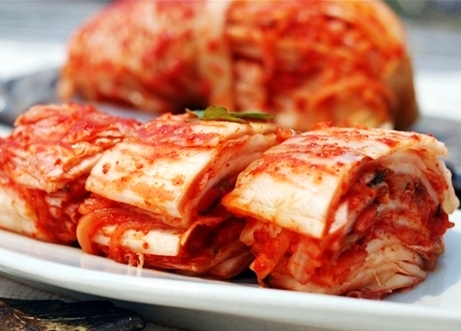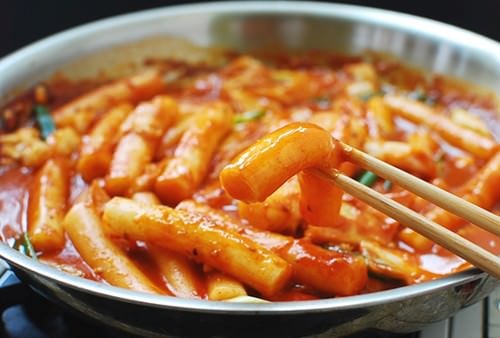Kimchi
As
you guys know Korea and the food is very synonymous, just like other countries.
Actually,
each country will inevitably have their own traditional food, as well as Korea,
would you really synonymous with this word, it is "Kimchi", for those
who do not know what is Kimchi, Kimchi is like a must-have-food for all Korean
people, no matter rich or poor.
As you know, the Kimchi is 100% vegetable; it
is not mixed with meat or chicken. Kimchi is known as salted vegetable, and
also spicy.
Who
loves spicy food, you need to try this. Compulsory…..
The
actual Kimchi's name is "shimchae", later changed to
"dimchae", then changed again to "kimchae", so that it
became "kimchi".
To
your knowledge, why kimchi can exist is because Korea is known as a country
that likes to ferment food and that's why kimchi exist.
As a tourist you can try making kimchi yourself.
You do not have to buy the ingredients of kimchi, you can come to Seoul Center
for Culture & Tourism located on the 5th floor of M Plaza Building (31-1,
Myeong-dong 2-ga, Jung-gu, Seoul). In this center, there are people who run the
events such as make traditional artifacts made with Hanji (traditional paper),
other than that you can try on Hanbok (traditional clothing) / court costumes)
and finally you can make kimchi.
To do it all, it is not free, you must pay for
it, but I believe the price worth it for those who want memories in Korea.
Bibimbap
To vegetable lover, this is food for you , and it called Bibimbap
Bibimbap literally means mixed rice or mixed meal in Korean.
It's a popular meal consisting of a bowl of steamed white rice topped with
vegetables, beef, a whole egg, and gochujang (red chili pepper paste).
Gochujang is usually served separately to control its spiciness of this rice
dish.
A variation of this dish, dolsot bibimbap (dolsot meaning
stone pot) is served in a heated stone bowl, in which a raw egg is cooked
against the sides of the bowl. Before the rice is placed in the bowl, the
bottom of the bowl is coated with sesame oil; consequently, the portion of the
rice touching the bowl becomes golden brown and crispy.
Vegetables commonly used in bibimbap include julienne
cucumber, zucchini, carrot, white radish, mushrooms, bellflower root (gaji
namul), and laver. It may also contain spinach, soybean sprouts, and bracken
fern stems (gosari namul). Tofu, either plain or sautéed, may also be included
in the dish as well. Within both types of bibimbaps, all ingredients are
typically stirred together thoroughly before eating.
For Muslim people, these foods are safe for your eat. Don't
worry.
Bulgogi
For
your information, Bulgogi is one of Korea's most popular beef dishes that is
made from thinly sliced sirloin or another prime cut of beef (rib eye). It is
usually marinated in a mixture of soy sauce, sesame oil, black pepper, garlic,
onions, ginger, and sugar for two to four hours to enhance the flavor and its
tenderization.
Bulgogi is traditionally grilled but broiling or pan-cooking is
common as well. Whole cloves of garlic, sliced onions, and chopped green
peppers are often grilled or cooked at the same time. It is often served to
non-Koreans as a first taste of Korean cuisine. (Muslims can eat this, but
still use have to find Muslims restaurant to eat this meat)
This
dish is usually served with a side of lettuce, spinach, or other leafy
vegetable, which is used to wrap a slice of cooked meat, often times along with
a dab of ssamjang, kimchi, or other side dishes, and then eaten as a whole. To
see a visual illustration, click here.
"Bul"
is the Korean word for fire and "gogi" is meat, therefore, it
translates into fire meat. However, it's not quite spicy in taste but somewhat
on the sweet side.
Patbingsu
Patbingsu is a popular shaved ice dessert enjoyed by all
ages especially during the hot and humid summer seasons in Korea. It originally
began as ice shavings mixed in with sweetened azuki beans known as pat and it
was usually sold by street vendors.
Nowadays, patbingsu has become a very
elaborate summer dessert, often topped with ice cream or frozen yogurt,
sweetened condensed milk, fruit syrups, rice cake bits, chewy jelly bits,
cereal flakes, and various fruits such as strawberries, kiwi fruit, and
bananas.
They are available in different flavors where green tea and
coffee are some of the popular varieties found at cafés in New York, Los
Angeles, or Atlanta.
Additionally, due to its extreme popularity, patbingsu is
even found on the menus of many Western-based fast food restaurants in Korea
such as KFC, McDonald's, and Burger King during summer times. Starbucks Korea
also released a frappuccino inspired by patbingsu.
Tteokkbokki
If you see Korean dramas, you'll see the actor eat
tteokbokki in some scene.This is
tteokbokki is one of Korea's popular snacks that are loved by teenagers
as well as adults. It is made from garaetteok, a chewy long cylindrical rice
pasta (or "rice cake") that is cut into many pieces and cooked with
various ingredients. It is a stir-fry dish which is cooked with gochujang (red
chili pepper paste) along with garaetteok, seasoned beef, fish cakes and assorted
vegetables such as green onions, carrots and onions.
A spicy version of tteokbokki is very popular but less spicy
ones can be also requested to meet everyone taste buds. In Korea, this snack
is commonly purchased from street. However, it can be found in Korean fast food
venues as well as some restaurants outside of Korea.






No comments:
Post a Comment